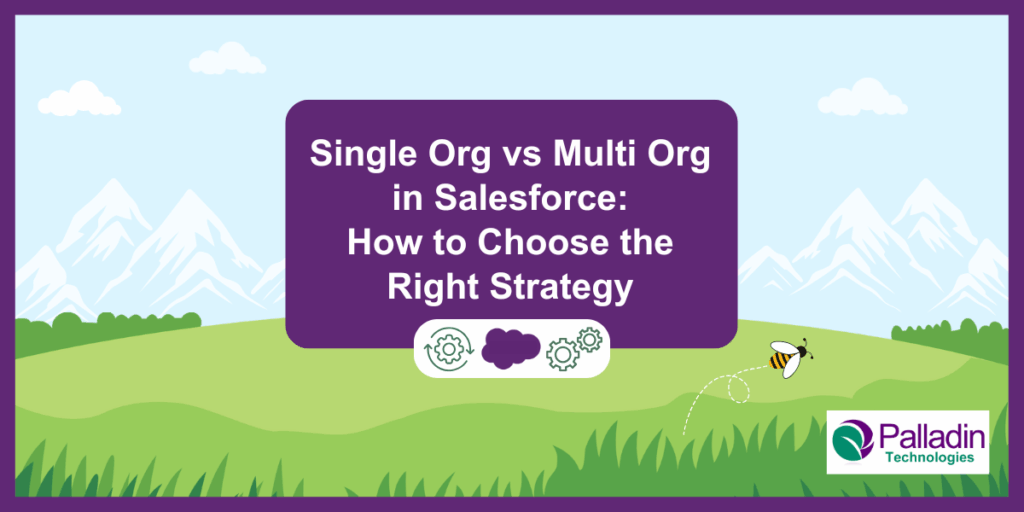When an enterprise scales on Salesforce, one of the most critical architectural decisions is whether to adopt a Single Org strategy or a Multi Org strategy. Both options come with their own set of benefits, risks, and trade-offs, and the right choice largely depends on business processes, compliance needs, and long-term scalability.
In this blog, we’ll walk through the considerations, benefits, and risks of each approach to help you make an informed decision.
Single Org Strategy
A single-org setup means running your entire business on one consolidated Salesforce org.
Benefits
- Standardized Business Processes – Enables consistency across all business processes like Sales, Service
- Customer 360° View – One place to see all customer interactions, improving visibility and reporting.
- Easy Reporting – OOB Salesforce tools work best when all data resides in one org.
- Collaboration – Shared data model fosters collaboration across business units.
- Centralized Support – One service desk, one entry point for issues.
- Efficiency & Governance – Common solutions, naming standards, and a strong Center of Excellence (CoE).
- Single Login – A simplified user experience with one authentication point.
Risks
- Org Complexity – A single org can become overly complex as different teams build functionality.
- Security Design Challenges – Permissioning and data visibility get harder to manage at scale.
- Development Overhead – Multiple teams working in one org requires strict governance, CI/CD, and mature release management.
- Performance & Limits – Higher risk of hitting Salesforce governor limits and LDV (Large Data Volume) challenges.
- Slower Time to Market – Competing priorities across LOBs can delay innovation.
- Costs Effective – Only one license required per user/ admin, no need to repeat integrations, extra sandboxes not required.
How to Mitigate:
- Establish a global CoE with a clear roadmap.
- Define roles & responsibilities using a RACI model.
- Invest in an Architecture Review Board.
- Implement robust DevOps practices (source control, CI/CD, environment management).
- Employ a Salesforce Data Architect for enterprise data strategy.
Multi Org Strategy
A Multi-org setup means running multiple Salesforce orgs, often separated by region, business unit, or compliance requirements.
Benefits
- Autonomy – Business units and regions can operate independently with their own processes.
- Faster Release/ Innovation – Each org can release features at its own pace.
- Compliance – Supports data residency and industry-specific regulations (GDPR, HIPAA, PIPL etc.).
- Simplified Complexity – Each org has its own data model, reducing configuration overhead.
- Lower Risk of Hitting Limits – Data and processing spread across multiple orgs.
- Easier Org-Wide Settings – Security, sharing, and org-specific configuration are easier to govern locally.
Risks
- Siloed Data – Harder to achieve a single Customer 360 view.
- Complex Reporting – Requires building a reporting hub or integration layer for consolidated insights.
- Reduced Reuse – Less ability to share configurations, code, or processes across orgs.
- Increased Costs – More licenses, admin teams, integrations, and sandboxes.
- SSO & Collaboration Challenges – No cross-org Chatter, more complex identity management.
- Release Management Complexity – Each org may need its own governance and testing cycles.
How to Mitigate:
- Establish governance committees and architectural review boards for each org.
- Set up a global CoE to define standards across orgs.
- Use a reporting hub or data lake for consolidated reporting.
- Standardize integration via ESB or APIs.
- Adopt a tiered administration model to empower LOBs while maintaining control.
How to Decide: Key Considerations
When choosing between single org and multi org, consider:
- Business Processes – Are they common or unique across regions/LOBs?
- Data Compliance – Do regulations require data segregation (GDPR, HIPAA, etc.)?
- Data Volumes & Limits – Will one org scale efficiently without hitting performance or governor limits?
- Collaboration Needs – How important is global collaboration vs. local autonomy?
- Cost & Support – Can you manage support, integrations, and licensing costs across multiple orgs?
Conclusion
There is no universal “right” answer to Single Org vs Multi Org & it depends on your enterprise’s structure, compliance needs, and growth strategy.
- If your business processes are standardized and you prioritize collaboration and unified reporting, a Single Org approach is ideal.
- If you have diverse processes, strict compliance requirements, or regional autonomy, a Multi Org strategy may be the better fit.
In many cases, organizations adopt a hybrid approach, keeping some processes in a global org while spinning off specialized or regional orgs as needed.
The most important factor is to plan with governance in mind. Whether single or multi, success on Salesforce comes from a strong CoE, well-defined architecture, and a clear roadmap.
Learn More About Partnering With Us!
Salesforce Lead Architect
Pratik Rudrakshe is a leading Salesforce Lead Architect with 17 Salesforce certifications. He has introduced 4 managed packages on the Appexchange and implemented a customer-facing journey in insurance using Vlocity Insurance, OmniOut, LWC, and the Newport Design System (NDS). Certified in Salesforce Industries/Vlocity CPQ and proficient in Vlocity and Salesforce LWC, Pratik also holds a Copado certification, highlighting his CI/CD process skills. His specialties include Salesforce Industry/Vlocity CPQ (Communications & Insurance), EPC, ESM, Contract Management, Vlocity LWC, Salesforce Lightning (LWC & Aura), Experience/Community Cloud, Salesforce Health Cloud, NPSP (Nonprofits Cloud), Integrations, CICD, Triggers, Apex, Visualforce, CPQ, Order Management, CTI Integration, JavaScript, CSS, and jQuery.

